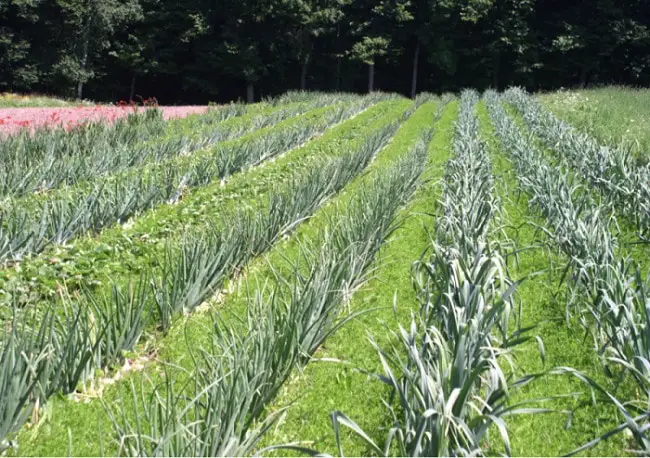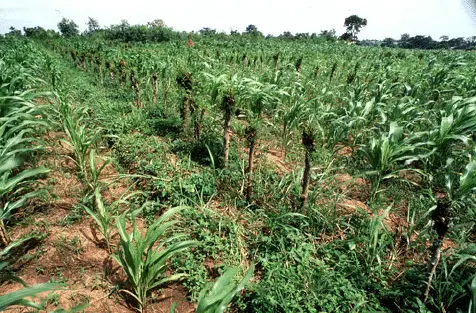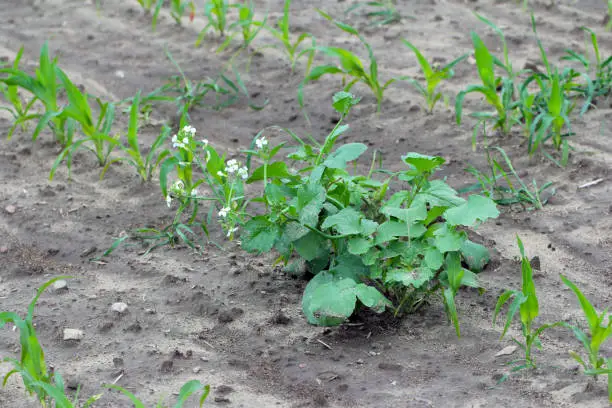Intercropping is a method of growing more than one crop in the same piece of land during the same crop season.
This is an environmentally friendly approach for pest control, crop protection and yield enhancement.
It results in increased and better nutrient recycling in the soil, stable yields, and control of pests and diseases with enhanced biodiversity.

Definition
Intercropping is defined as growing two or more crops simultaneously on the same land.
One can notice crop intensification in terms of both space and time dimensions under the inter-cropping system.
The major benefit is it increases the production per unit area compared to single cropping through the effective use of resources and nutrients, including water and solar energy. Inter-cropping is preferred over sole cropping as a result of superior yield due to the efficient utilization of available resources.
Main Crop or Base Crop
The base crop is one that is grown as a main source of income on the farm. A suitable intercrop is grown between the vacant spaces of the main crop.
Intercrop is the plantation of different crops between the main crop’s vacant spaces.
It tends to have a short life cycle and is mainly grown with the intention of additional revenue, but it also mitigates losses during main crop failure.
Different types of intercropping systems
1. Mixed Intercropping or Mixed Cropping
Growing two or more crops simultaneously on the same piece of land with no distinct row arrangement
2. Row Method

It is a kind where different crops are grown at the same time on the same piece of land with a distinct row arrangement.
3. Patch method

In this method, intercrops are grown in patches in vacant spaces on the same piece of land.
4. Strip cropping
In this method, we will grow more than one crop in strips to allow independent cultivation in the same piece of land.
5. Relay Intercropping
In relay cropping, intercrops are sown or planted when the main crops reach maturity. But it is done before harvesting of the base crop.
6. Parallel Intercropping
In this method, both selected intercrop and main crops have different growing habits.
Hence, there will be zero competition for the available resources. So, both crops can express their full yield potential.
7. Multi-Storied Intercropping
In multistoried intercropping, crops with different heights are selected.
Mostly, this method is adopted for plantation crops.
8. Alley cropping
Alley cropping is a kind of agroforestry system where intercrops are grown in the alleys of trees and hedges, etc.
9. Guard Crops
The main crop is grown in the center, where hardy or thorny crops surround it. Thus, the main crop gets protection with the help of gourd crops.
Guard crops are mainly planted with a view to protect the main crop.
Example: Safflower with thorny bushes can protect other crops.
10. Trap cropping
Traps crops like marigolds and mustard, etc., are intercropped in between the main crop to trap various insect pests.
11. Filler Cropping

It is a method of cropping in which newly established orchards are planted with other filler crops in the juvenile period of the main crop.
This helps in efficient utilization of space to earn some extra profits.
12. Mixed Cropping

It is said to be mixed cropping when two or more crops are grown on the same piece of land.
In mixed cropping, seeds of different crops are mixed and sown or broadcasted.
Mixed cropping is popular in areas prone to natural calamities like drought, frost, etc.
Further, though all the crops are sown at the same time, they mature at different times.
Mixed cropping may cause problems in harvesting and carrying out intercultural operations.
Rules to follow in the selection of inter crops
Caution should be ensured while selecting crops with different growth habits, duration, root growth, taxonomical families, etc.
- Grow tall-growing crops along with bushy crops.
- Select shallow-rooted crops as intercrops in the deep-rooted crop.
- Long-duration crops should be intercropped with short-duration crops.
- Grow slow-growing crops in vacant spaces of fast-growing crops.
- Selected main crops and intercrops should show a very negligible allelopathic effect.
- Need to intercrop non-legumes with intercrops.
- Crops selected should be of different families to avoid various pests and diseases.
Advantages of intercropping
- Better utilization of growth resources like nutrients, light, and moisture.
- Mitigate losses where the failure of any one of the component crops occurs.
- A farmer can get extra yield from the unit area.
- Better utilization of space available with the time dimensions.
- We can achieve better weed control by growing intercrops.
- Minimizes the chances of soil crust formation.
- Mitigate losses where the failure of any one of the component crops occurs.
- Intercrops will also enhance soil fertility.
- Controls soil erosion.
- To some extent, the pests and diseases of the main crop are controlled.
- Ecological stability.
- Cultivation practices for the major crop will also supplement companion crop requirements.
- It provides shading and physical support to some crops.
- It provides extra income to the farmers.
- It provides daily needs for the farmers.
- Intercropping will also generate extra employment for agrarian people.
Disadvantages of intercropping
- Sometimes, intercrops work as alternate hosts for various pests and diseases.
- Differential maturity and sometimes harvesting may become a problem.
- It becomes difficult to control various pests and diseases.
- Intercropping is a labor-intensive practice.
- Allelopathic effect. (Plants produce biochemicals that influence the growth and reproduction of others.)
- Possibility of problems in carrying out intercultural operations.
- Difficulty in mechanization.
- There might arise competition among the component crops.
References:

Thanks for the good work
it’s really helpful for my physical science project
Jensen, glad to know that you found it helpful.
Thanks a lot for such great helpful work.it has contributed a lot towards my research in my DITTE program.
Hi, you are welcome.